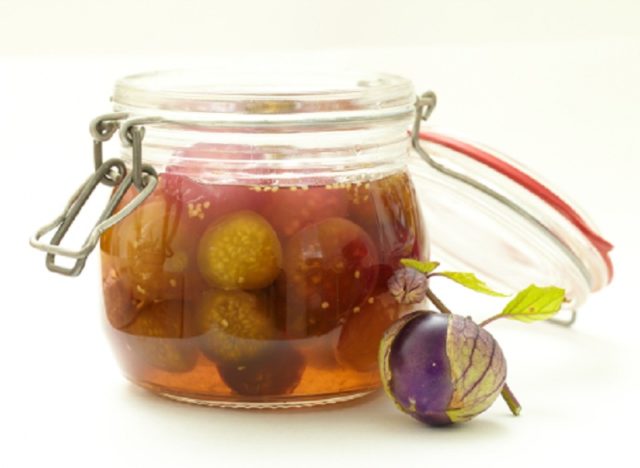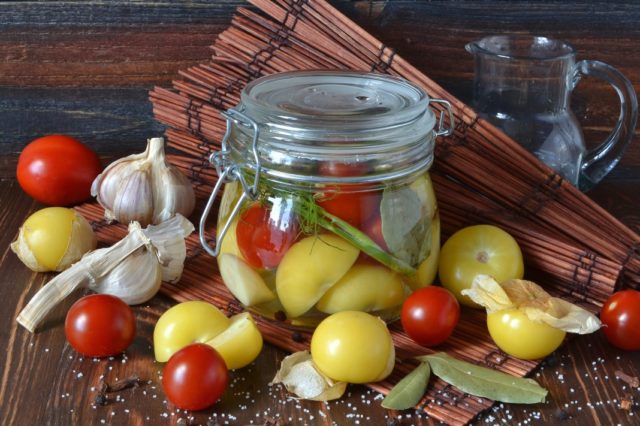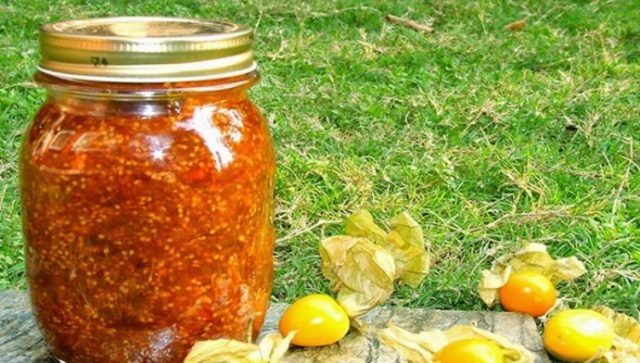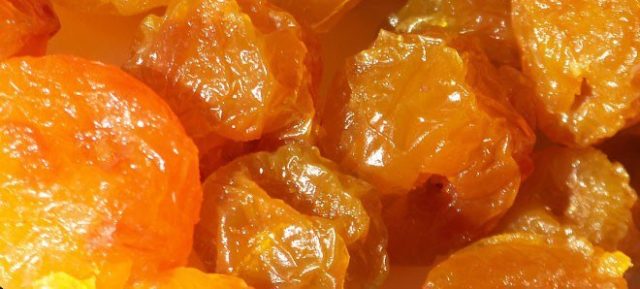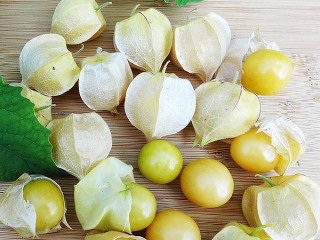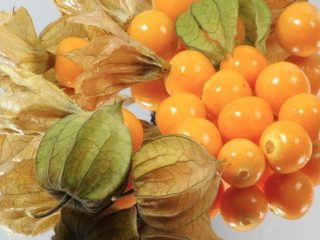Content
Not everyone, having heard about physalis, will immediately understand what is at stake. Although many gardeners have long been familiar with this exotic representative of the nightshade, not all of them know that many interesting, tasty and healthy dishes can be prepared from almost any of its varieties for the winter. Recipes for making physalis for the winter are not very diverse - after all, unlike the same tomatoes, a close acquaintance with this plant began only about half a century ago. Nevertheless, many dishes turn out to be very tasty and so original that they will easily intrigue guests at the festive table.
What to cook from physalis for the winter
As the physalis plants themselves are usually divided into vegetables and berries, so dishes from it are subdivided into spicy pickled and sweet ones.
Indeed, very tasty pickled, salted and soaked preparations for the winter are prepared from vegetable physalis, both independently and as additives to other vegetables.
For preserves and jams, both vegetable and berry varieties are suitable. But for cooking candied fruits, dried fruits, compotes and jelly for the winter, it is berry varieties that are best suited.
To remove the sticky substance from the surface of the fruits of vegetable physalis, it is necessary, after having cleaned from the cases, to blanch for a couple of minutes in boiling water or at least scald with boiling water. Berry varieties can be eliminated from this procedure as they usually lack a sticky coating.
Physalis recipes for the winter
Since physalis is not yet very familiar as a raw material for preparations for the winter, it is recommended to try a few recipes with or without a photo for a start, and use small portions to prepare a particular dish. The fruits of this plant ripen gradually, and this is very convenient. Since, having made a certain amount of this or that preparation from the first ripened batch and tried it, you can immediately determine whether it is worth contacting and preparing all the remaining fruits according to this recipe or not.
Cooking physalis for the winter according to the classic recipe
The process of preparing pickled physalis for the winter, in fact, does not differ from pickling the same tomatoes or cucumbers.
To do this, prescription will require:
- 1 kg of physalis fruit;
- 5-7 carnation buds;
- 4 peas of black and allspice;
- a pinch of cinnamon;
- lavrushka leaves to taste;
- 1 liter of water;
- 50 g of sugar and salt;
- 15 ml of 9% vinegar;
- dill umbrellas, cherry leaves, black currant and horseradish to taste and desire.
There are 2 main ways to marinate physalis. In the first case, the fruits are placed in clean jars, sprinkled with spices, poured with boiling marinade made from water, sugar, salt and vinegar, and sterilized for 18-20 minutes.
If you want to do without sterilization, use the threefold filling method:
- At the bottom of the prepared jars, place half of the herbs with spices, then physalis and the rest of the seasonings on top.
- The jar is poured with boiling water and left under the lid for 15 minutes.
- Then the water is drained, a marinade is prepared from it (without vinegar) and, in a boiling state, physalis is again poured into it in glass containers.
- After 15 minutes of settling, the marinade is again drained, heated to + 100 ° C, vinegar is added to it and again poured into jars.
- Pickled physalis is immediately hermetically rolled up and placed upside down under a blanket for additional sterilization.
The workpiece will acquire its final taste only after a month.
Spicy pickled physalis
Physalis, even vegetable, has very delicate fruits, the taste of which can be spoiled by too aggressive or vigorous marinade, so here it is important not to overdo it and strictly follow the recipe recommendations.
You will need:
- 1000 g of physalis peeled from covers;
- 1 liter of water;
- 1 tsp dry mustard seeds;
- half a pod of hot pepper;
- 5 peas of allspice;
- 4-5 cloves of garlic;
- 2 carnation buds;
- 2 bay leaves;
- 40 g salt;
- 1 tbsp. l. vinegar essence;
- 50 g of sugar.
The cooking process itself is similar to that described in the previous recipe. At the same time, hot peppers and garlic are cleaned of unnecessary parts and cut into small pieces. Together with the mustard seeds, the vegetables are laid out approximately equally in the prepared jars.
With tomato juice
Physalis pickled in this form practically does not differ from canned cherry tomatoes. According to this recipe, even vinegar is not needed, since tomato juice will play the role of acid.
To prepare such a simple and at the same time unusual snack for the winter, according to the recipe, you will need:
- about 1 kg of fruits of vegetable or berry physalis;
- 1.5 liters of store-bought or self-made tomato juice;
- 1 medium horseradish root;
- 50 g celery or parsley;
- several leaves of lavrushka and black currant;
- 3 cloves of garlic;
- 70 g salt;
- 75 g sugar;
- 5 black peppercorns;
- several dill umbrellas.
Preparation:
- The fruits are removed from the cases and, if necessary, blanched in boiling water (if vegetable varieties are used).
- To make tomato juice in homemade recipes, it is enough to boil the tomatoes cut into pieces for a quarter of an hour. And then, after cooling, rub the tomato mass through a sieve. Or you can just use a juicer, if available.
- To prepare the marinade, sugar, salt, lavrushka and black pepper are added to tomato juice, and heated until boiling.
- Meanwhile, all the remaining spices are placed in sterilized jars, physalis is placed on top.
- Pour the contents of the jars with boiling tomato marinade and immediately seal them for the winter.
- Cool upside down under a warm shelter.
With tomatoes
There is also a very interesting recipe for the winter, in which physalis is marinated not in splendid isolation, but in the company of vegetables and fruits that are very suitable to it in taste and texture. The unusual taste and appearance of the workpiece will surely surprise any guests.
You will need:
- 500 g physalis;
- 500 g of tomatoes;
- 200 g plums;
- 1 liter of water;
- 50 g salt;
- 100 g sugar;
- on a sprig of tarragon and basil;
- 50 ml of fruit vinegar (apple cider or wine).
Preparation:
- Physalis, tomatoes and plums are pricked with a toothpick and scalded with boiling water.
- Then they are laid out in glass containers, the necessary and desired seasonings are added.
- Boil water with salt and sugar, add vinegar at the end.
- The containers are poured with boiling marinade, sterilized for 10 minutes and rolled up for the winter.
With spices
In the same way, you can prepare physalis for the winter with a variety of spicy additives.
For 1 kg of fruit and, accordingly, 1 liter of water for the marinade add:
- 15 carnation buds;
- 4 cinnamon sticks;
- 15 peas of allspice;
- 100 g of various herbs (horseradish, currant, cherry, oak leaves, dill inflorescences, tarragon, hyssop, celery, parsley, basil);
- a few leaves of lavrushka;
- 50 ml of 9% vinegar;
- 60 g sugar;
- 40 g of salt.
Salted physalis
Physalis can be salted for the winter in the same way as it is done with tomatoes and cucumbers.
You will need:
- 1 kg of physalis;
- 3-4 cloves of garlic;
- a small horseradish root;
- 30 g of dill inflorescences;
- 5-7 peas of black pepper;
- cherry and black currant leaves, if desired and available;
- 60 g salt;
- 1 liter of water.
Preparation:
- Prepare brine from water and salt, boil and cool.
- Fill clean jars with physalis fruits mixed with spices.
- Pour with brine, cover with a linen cloth and leave at room temperature for 8-10 days to ferment.
- If foam and mold appear during fermentation, they must be removed from the surface.
- After the expiration of the prescribed period, the brine is drained, heated to a boil, boiled for 5 minutes and poured back into the jars.
- Salted physalis are rolled up and stored for the winter in a cool place.
Caviar
Caviar is traditionally prepared from vegetable or Mexican physalis. The dish turns out to be very tender and so unusual in taste that it is difficult to understand what it is made of.
You will need:
- 2 kg of physalis vegetable varieties;
- 1 kg of onions;
- 1 kg of carrots;
- garlic to taste;
- one bunch of dill and parsley greens;
- 450 ml of vegetable oil;
- 45 ml vinegar 9%;
- salt to taste.
Preparation:
- All vegetables are peeled or husked and finely chopped.
- Fry in a pan separately from each other: onions - 5 minutes, carrots - 10 minutes, physalis - 15 minutes.
- Mix everything in a separate container with thick walls, add oil and put in an oven heated to + 200 ° C.
- After half an hour, add chopped herbs and garlic.
- Add sugar, salt, spices to taste.
- At the very end of the stewing, vinegar or citric acid is added.
- Hot vegetable caviar is laid out in sterile jars and rolled for the winter.
Compote
Compote for the winter is best prepared from berry varieties, in which there is more sugar and aromatic components, thanks to which the drink turns out to be very tasty and fragrant.
You will need:
- 400 g of berry physalis;
- 220 g granulated sugar;
- 200 ml of purified water.
According to this recipe, the compote is very concentrated. When consumed, it is advisable to dilute it with water to taste.
Preparation:
- Physalis must be pricked with a sharp object in many places, then dipped in boiling water for a minute.
- After that, the berries are taken out with a colander and placed in cold water, where the amount of sugar prescribed by the recipe is also added.
- The compote is heated until the water boils and boiled for 5 to 10 minutes.
- Taste if it is too sweet, add a pinch of citric acid or juice from half a lemon.
- The berries are transferred to sterile jars, poured with boiling syrup, immediately rolled up and placed to cool under a warm "fur coat".
Jam
Traditional physalis jam is brewed in several stages. It is especially aromatic and tasty from berry varieties. But in their absence, a completely tasty preparation can also be obtained from vegetable varieties of physalis, especially if you use vanillin and ginger additives.
You will need:
- 1000 g physalis fruit;
- 1200 g sugar;
- 20 g fresh ginger root;
- 1 lemon;
- 1 g vanillin;
- 200g of water.
Preparation:
- Physalis fruits are selected from the covers and pierced with a fork in several places.
- The ginger is peeled and cut into thin slices.
- Cut the lemon together with the skin into small thin pieces, selecting all the seeds from it.
- Then the slices of ginger and lemon are poured over with boiling water and boiled in it for several minutes.
- Sugar is added to the broth and heated until it is completely dissolved.
- Physalis fruits are placed in the prepared syrup, heated for about 5 minutes and set aside until they cool completely.
- Put the pan with the future jam on the fire again, stand after boiling for 10 minutes, add vanillin and cool again for at least 5-6 hours.
- When the jam is placed on the fire for the third time, the physalis should become almost transparent, and the dish itself should acquire a pleasant honey tint.
- It is boiled over low heat for about 10 minutes and packaged in dry jars.
Raisins and candied fruits
The most delicious and original preparation of physalis berry varieties is the so-called raisins. The product is much more original in taste than grape raisins and has an attractive fruity aroma.
- The berries are peeled, rinsed in water and laid out in one layer on a tray or baking sheet.
- Most varieties dry easily in the sun for several days. If there is no sun, then you can use an oven or electric dryer at a temperature of about + 50 ° C.
- But to dry varieties of Peruvian physalis, you should only use a dryer or oven with forced ventilation. Since very delicate fruits can quickly deteriorate in the sun.
Children enjoy dried physalis with pleasure, it is also used for making pilaf, drinks, fillings. Candied fruits are best suited for decorating pastries and pastries.
Cooking them is also not very difficult, this will require:
- 1 kg of physalis berries;
- 1 glass of water;
- 1.3 kg of sugar.
Preparation:
- Chopped physalis berries are placed in a boiling syrup of water and sugar, boiled for 5 minutes and cooled for about 8 hours.
- This procedure is repeated at least 5 times.
- Finally, the syrup is poured through a colander, and the berries are allowed to dry slightly.
- Then they are laid out on parchment paper and dried in the air or in the oven.
- If desired, roll in powdered sugar and put in cardboard boxes for storage.
Terms and conditions of storage
All physalis blanks, sealed with metal lids, can be stored in a regular room pantry for a year. Candied fruits and raisins also store well in standard room conditions until the new season.
Conclusion
Recipes for cooking physalis for the winter, collected in this article, can help novice housewives understand how to use a mysterious and exotic fruit called physalis. And since it is much easier to grow it than tomatoes, the blanks from it will help diversify the winter menu of any family.
